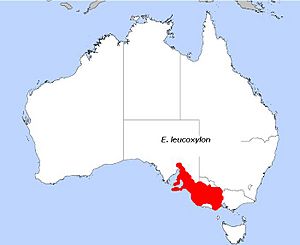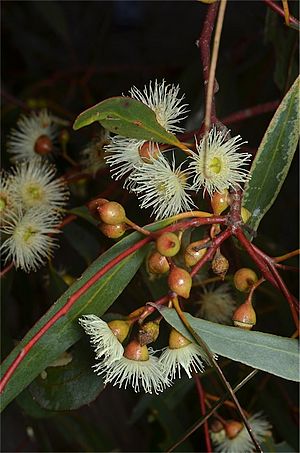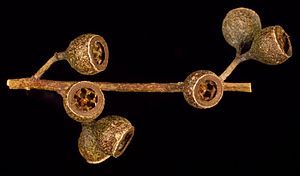Yellow gum facts for kids
Quick facts for kids Blue gum, yellow gum |
|
|---|---|
 |
|
| Eucalyptus leucoxylon, in Maranoa Gardens, Melbourne | |
| Scientific classification | |
| Genus: |
Eucalyptus
|
| Species: |
leucoxylon
|
 |
|
| E. leucoxylon, field distribution | |
The Yellow Gum (scientific name: Eucalyptus leucoxylon) is a tree found only in southeastern Australia. People also call it Blue Gum or White Ironbark. This tree is usually small to medium-sized. It has smooth, yellowish bark, but some rough bark near its base. Its adult leaves are shaped like a spear or are slightly curved. The flowers grow in groups of three and can be white, red, or pink. The fruit looks like a cylinder, a barrel, or a round ball. Many people grow this tree in their gardens.
Contents
What the Yellow Gum Looks Like
The Yellow Gum tree usually grows to be about 10 to 30 meters tall. It has smooth bark that can be white, yellow, or bluish-grey. Near the bottom of the trunk, the bark is often rough and flaky for about 0.5 to 2 meters.
Leaves and Flowers
Young Yellow Gum plants have leaves that are mostly in pairs. These leaves are egg-shaped or wide and spear-shaped, about 45 to 105 millimeters long. Adult leaves grow one after another, not in pairs. They are slightly shiny green on both sides, spear-shaped, and about 60 to 185 millimeters long.
The flower buds grow in groups of three. They are oval or diamond-shaped, about 6 to 17 millimeters long. The flowers can be white, red, or pink, and the tree can bloom in most months of the year.
Fruit
After flowering, the tree produces a woody fruit. This fruit is called a capsule and can be shaped like a cylinder, a barrel, or a flattened ball. It is about 6 to 13 millimeters long.
How it is Different from Other Trees
The Yellow Gum is similar to other eucalyptus trees like the Yellow Box and Mugga Ironbark. However, you can tell the Yellow Gum apart because its flower buds always grow in groups of three.
Naming the Yellow Gum
The scientific name Eucalyptus leucoxylon was first officially described in 1855. This was done by a scientist named Ferdinand von Mueller.
Meaning of the Name
The name leucoxylon comes from two ancient Greek words. "Leuco-" means "white," and "-xylon" means "wood." So, the name basically means "white wood."
Types of Yellow Gum Trees
There are different types, or subspecies, of Yellow Gum trees. Here are some of them:
- Eucalyptus leucoxylon subsp. bellarinensis: This type has rough bark near the bottom of its trunk. Its young leaves are waxy and joined together in pairs. Its flower buds are round, and its fruit is quite large.
- Eucalyptus leucoxylon subsp. connata: This type is similar to the main Yellow Gum, but its flower buds are round instead of oval.
- Eucalyptus leucoxylon subsp. leucoxylon: This is the most common type. Its leaves are not waxy, and its young leaves are never joined in pairs. Its adult leaves are less than 25 millimeters wide, and its flower buds are oval.
- Eucalyptus leucoxylon subsp. megalocarpa: This type is similar to the main Yellow Gum, but its adult leaves are wider than 25 millimeters.
- Eucalyptus leucoxylon var. pluriflora
- Eucalyptus leucoxylon subsp. pruinosa: This type has a waxy coating on its young leaves, flower buds, and fruit. It also has white flowers.
Where the Yellow Gum Grows
You can find the Yellow Gum in the southeastern parts of Australia. This includes the state of Victoria, southeastern South Australia, and a small part of southwestern New South Wales.
Specific Locations for Subspecies
All six types of Yellow Gum grow in Victoria.
- Subspecies bellarinensis is only found near Ocean Grove and Torquay on the Bellarine Peninsula.
- Subspecies connata grows in rocky soil, mostly in the Brisbane Ranges.
- Subspecies leucoxylon is the most common and grows in many places across Victoria and southeastern South Australia. The tallest ones are found on Kangaroo Island.
- Subspecies megalocarpa is a smaller tree or shrub that grows only in coastal areas from southeastern South Australia to western Victoria.
- Subspecies pruinosa grows in drier areas of South Australia, the Wimmera, and the Goldfields region of Victoria. It also grows near Barham in New South Wales.
How People Use Yellow Gum
Yellow Gum trees are useful in a few ways.
Essential Oils
The leaves of the Yellow Gum are used to make eucalyptus oil. This oil is known for its fresh, clean smell and is often used in medicines or cleaning products.
Growing in Gardens
Many people plant Yellow Gum trees in their gardens and parks.
- Subspecies megalocarpa is popular because it is a smaller tree with beautiful red flowers and large fruit. It blooms a lot in winter and is often called ‘Rosea’ when sold in nurseries.
- A type called 'Euky Dwarf' is very popular for planting along streets and in gardens. It grows to be about 5 to 6 meters tall and 3 to 4 meters wide.
- The main subspecies, leucoxylon, is suggested for bigger gardens and parks.
Images for kids
See also
 In Spanish: Corteza blanca de hierro para niños
In Spanish: Corteza blanca de hierro para niños





